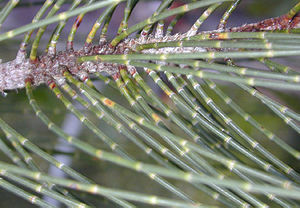What does casuarinaceae mean?
Definitions for casuarinaceae
ca·suar·i·naceae
This dictionary definitions page includes all the possible meanings, example usage and translations of the word casuarinaceae.
Princeton's WordNet
Casuarinaceae, family Casuarinaceaenoun
one genus: genus Casuarina
Wikipedia
Casuarinaceae
The Casuarinaceae are a family of dicotyledonous flowering plants placed in the order Fagales, consisting of four genera and 91 species of trees and shrubs native to eastern Africa, Australia, Southeast Asia, Malesia, Papuasia, and the Pacific Islands. At one time, all species were placed in the genus Casuarina. Lawrence Alexander Sidney Johnson separated out many of those species and renamed them into the new genera of Gymnostoma in 1980 and 1982, Allocasuarina in 1982, and Ceuthostoma in 1988, with some additional formal descriptions of new species in each other genus. At the time, it was somewhat controversial. The monophyly of these genera was later supported in a 2003 genetics study of the family. In the Wettstein system, this family was the only one placed in the order Verticillatae. Likewise, in the Engler, Cronquist, and Kubitzki systems, the Casuarinaceae were the only family placed in the order Casuarinales. Members of this family are characterized by drooping equisetoid (meaning "looking like Equisetum"; that is, horsetail) twigs, evergreen foliage, monoecious or dioecious and infructescences ('fruiting bodies') cone-like, meaning combining many outward-pointing valves, each containing a seed, into roughly spherical, cone-like, woody structures. The roots have nitrogen-fixing nodules that contain the soil actinomycete Frankia.In Australia, the most widely used common name for Casuarinaceae species is sheoak or she-oak (a comparison of the timber quality with English oak). Other common names in Australia include ironwood, bull-oak or buloke, beefwood, or cassowary tree.The Shire of Buloke in Victoria, Australia, is named after the species Allocasuarina luehmannii.
ChatGPT
casuarinaceae
Casuarinaceae is a family of flowering plants mostly found in Australia, Southeast Asia, West Indies, and the Pacific Islands. The family consists of four genera and 91 species, all of which are evergreen woody plants, including trees and shrubs. Their leaves are reduced to small scales, making the branches resemble horsetails. These plants are also known for their ability to improve soil fertility by forming a symbiotic relationship with nitrogen-fixing bacteria.
Wikidata
Casuarinaceae
Casuarinaceae are a family of dicotyledonous flowering plants placed in the order Fagales, consisting of three or four genera and about 70 species of trees and shrubs native to the Old World tropics, Australia, and the Pacific Islands. At one time, all of the species were placed in the genus Casuarina, but these were split in 1980, 1982 & 1988 into the genera Allocasuarina, Casuarina, Ceuthostoma, and Gymnostoma. Somewhat controversial at the time, the monophyly of these genera was later supported in a 2003 molecular study of the family. In the Wettstein system, this family was the only one placed in the order Verticillatae. Likewise, in the Engler, Cronquist and Kubitzki systems, the Casuarinaceae were the only family placed in the order Casuarinales. Members of this family are characterized by drooping equisetoid twigs, are evergreen, and monoecious or dioecious. The roots have nitrogen-fixing nodules that contain the soil actinomycete Frankia. The most widely used common name for Casuarinaceae species is sheoak or she-oak. Other common names include ironwood, bull-oak or buloke, and beefwood.
Matched Categories
Numerology
Chaldean Numerology
The numerical value of casuarinaceae in Chaldean Numerology is: 1
Pythagorean Numerology
The numerical value of casuarinaceae in Pythagorean Numerology is: 2
Translation
Find a translation for the casuarinaceae definition in other languages:
Select another language:
- - Select -
- 简体中文 (Chinese - Simplified)
- 繁體中文 (Chinese - Traditional)
- Español (Spanish)
- Esperanto (Esperanto)
- 日本語 (Japanese)
- Português (Portuguese)
- Deutsch (German)
- العربية (Arabic)
- Français (French)
- Русский (Russian)
- ಕನ್ನಡ (Kannada)
- 한국어 (Korean)
- עברית (Hebrew)
- Gaeilge (Irish)
- Українська (Ukrainian)
- اردو (Urdu)
- Magyar (Hungarian)
- मानक हिन्दी (Hindi)
- Indonesia (Indonesian)
- Italiano (Italian)
- தமிழ் (Tamil)
- Türkçe (Turkish)
- తెలుగు (Telugu)
- ภาษาไทย (Thai)
- Tiếng Việt (Vietnamese)
- Čeština (Czech)
- Polski (Polish)
- Bahasa Indonesia (Indonesian)
- Românește (Romanian)
- Nederlands (Dutch)
- Ελληνικά (Greek)
- Latinum (Latin)
- Svenska (Swedish)
- Dansk (Danish)
- Suomi (Finnish)
- فارسی (Persian)
- ייִדיש (Yiddish)
- հայերեն (Armenian)
- Norsk (Norwegian)
- English (English)
Word of the Day
Would you like us to send you a FREE new word definition delivered to your inbox daily?
Citation
Use the citation below to add this definition to your bibliography:
Style:MLAChicagoAPA
"casuarinaceae." Definitions.net. STANDS4 LLC, 2024. Web. 25 Apr. 2024. <https://www.definitions.net/definition/casuarinaceae>.



Discuss these casuarinaceae definitions with the community:
Report Comment
We're doing our best to make sure our content is useful, accurate and safe.
If by any chance you spot an inappropriate comment while navigating through our website please use this form to let us know, and we'll take care of it shortly.
Attachment
You need to be logged in to favorite.
Log In